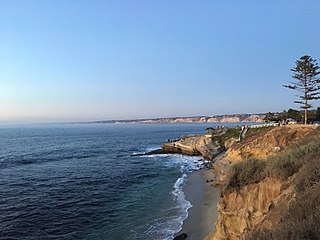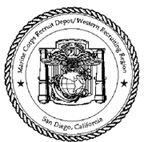
The University of California, San Diego is a public land-grant research university in La Jolla, California. Established in 1960 near the pre-existing Scripps Institution of Oceanography, UC San Diego is the southernmost of the ten campuses of the University of California, and offers over 200 undergraduate and graduate degree programs, enrolling 33,096 undergraduate and 9,872 graduate students. The university occupies 2,178 acres (881 ha) near the coast of the Pacific Ocean, with the main campus resting on approximately 1,152 acres (466 ha). UC San Diego is ranked among the best universities in the world by major college and university rankings.

Marine Corps Base Camp Pendleton is the major West Coast base of the United States Marine Corps and is one of the largest Marine Corps bases in the United States. It is on the Southern California coast in San Diego County and is bordered by Oceanside to the south, San Clemente and Orange County to the north, Riverside County to the northeast, and Fallbrook to the east.

La Jolla is a hilly, seaside special community within San Diego, occupying 7 miles (11 km) of curving coastline along the Pacific Ocean. The population reported in the 2010 census was 46,781.

Marine Corps Recruit Depot Parris Island is an 8,095-acre (32.76 km2) military installation located within Port Royal, South Carolina, approximately 5 miles (8.0 km) south of Beaufort, the community that is typically associated with the installation. MCRD Parris Island is used for United States Marine Corps Recruit Training of enlisted United States Marines. Recruits living east of the Mississippi River report there to receive initial training. Recruits living west of the Mississippi River receive training at Marine Corps Recruit Depot San Diego, California, but may train at MCRD Parris Island by special request.

Marine Corps Recruit DepotSan Diego is a United States Marine Corps military installation in San Diego, California. It lies between San Diego Bay and Interstate 5, adjacent to San Diego International Airport and the former Naval Training Center San Diego. MCRD San Diego's main mission is the initial training of enlisted male and female recruits living west of the Mississippi River. Over 21,000 recruits are trained each year. As of 2022, 1.5 million recruits have completed their boot camp training at the Depot. The Depot also is the home to the Marine Corps' Recruiter School and Drill Instructors School.
The School of Infantry (SOI) is the second stage of initial military training for enlisted United States Marines after recruit training. Since the initial training pipeline is divided between coasts, Marines from areas east of the Mississippi River usually graduate from MCRD Parris Island and move on to SOI at SOI East, while those from the western half of the nation attend MCRD San Diego and move on to SOI West at the Camp San Onofre area of Camp Pendleton in California. Female Marines are trained at both SOI East and SOI West. The School of Infantry's training mission ensures "Every Marine is, first and foremost, a Rifleman". At SOI, Marines with the Military Occupational Specialty of infantry are trained at the Infantry Training Battalion (ITB), while all non-infantry Marines are trained in basic infantry and combat skills at the Marine Combat Training Battalion. SOI marks a transition in the professional training of entry-level students from basically trained Marines to combat-ready Marines.

Edson Range is a firing range complex at Marine Corps Base Camp Pendleton, near Oceanside, California. It is named for Marine Major General "Red Mike" Edson, "a World War II Medal of Honor recipient and a distinguished small arms marksman proponent." This rifle-qualification complex is home to four of the largest firing ranges on the base. The range became operational on August 21, 1964, the same day that Camp Calvin B. Matthews, in La Jolla, California, was closed and turned over to the University of California. Camp Matthews had previously been used for rifle training.

The Preuss School, Preuss School UCSD, or Preuss Model School is a coeducational college-preparatory charter day school established on a $14 million campus situated on the University of California San Diego (UCSD) campus in La Jolla, California, United States. The school was named in recognition of a gift from the Preuss Family Foundation and is chartered under the San Diego Unified School District (SDUSD).

Private First Class Gary Wayne Martini was a United States Marine who posthumously received the Medal of Honor for heroism in April 1967 during the Vietnam War.

The University of California San Diego School of Medicine is the graduate medical school of the University of California, San Diego. It was the third medical school in the University of California system, after those established at UCSF and UCLA, and is the only medical school in the San Diego metropolitan area. It is closely affiliated with the medical centers that are part of UC San Diego Health.

University City (UC) is a community in San Diego, California, located in the northwestern portion of the city next to the University of California, San Diego. University City is bordered by La Jolla and Interstate 5 to the west, Miramar and Interstate 805 to the east, and North Clairemont and Highway 52 to the south, giving the community a triangular-shaped boundary. University City is a part of District 1, which is represented by Councilmember Joe LaCava on the San Diego City Council.

Birch Aquarium at Scripps is an aquarium and the public outreach center for Scripps Institution of Oceanography at the University of California, San Diego. Accredited by the Association of Zoos and Aquariums, Birch Aquarium at Scripps has an annual attendance of more than 439,000, including more than 40,000 school children, and features more than 3,000 animals representing 380 species. The hilltop site provides views of the Scripps Institution of Oceanography campus and the Pacific Ocean. The mission of the aquarium reads: "At Birch Aquarium at Scripps, we connect understanding to protecting our ocean planet".

Camp Kearny was a U.S. military base in San Diego County, California, on the site of the current Marine Corps Air Station Miramar. It operated from 1917 to 1946. The base was named in honor of Brigadier General Stephen W. Kearny.

United States Marine Corps Recruit Training is a 13-week program, including in & out-processing, of recruit training that each recruit must successfully complete in order to serve in the United States Marine Corps.
The MCRD San Diego Command Museum is located in Day Hall, Building 26, Marine Corps Recruit Depot San Diego, San Diego, California. It exhibits historical items relating to the United States Marine Corps. The museum opened on November 10, 1987, and was officially designated as a command museum on January 8, 1993.
Camp Callan was a United States Army anti-aircraft artillery replacement training center that was operational during World War II. It was located on the southern west coast of the United States, north of San Diego at La Jolla, California. The facility was closed shortly after the war ended and few traces of the base remain.

The Midway area, also referred to as the North Bay area, is a neighborhood of San Diego, California. It is located at the northern (mainland) end of the Point Loma peninsula, northwest of Downtown San Diego and just west of Old Town. It is often considered to be part of Point Loma, although the city treats it as a separate Planning Area.

The 3rd Recruit Training Battalion is composed of four training companies; India, Kilo, Lima and Mike. The recruit training battalion is responsible ensuring that each company is following the procedures set forth by the Recruit Training Regiment. Each company is responsible to follow the standards established by the Commandant of the Marine Corps to train, teach, mentor, and above all lead recruits through a demanding standard-based training system. 51% of all male Marines attend recruit training at Marine Corps Recruit Depot, San Diego, California.

The Marine Recruit Training Regiment San Diego (MCRDSD), based at San Diego, California, is a training regiment of the United States Marine Corps. It is composed of three recruitment battalions and three recruit training battalions: 1st, 2nd, 3rd. Each battalion is responsible for ensuring that each company within it is following the procedures set forth by the Recruit Training Regiment. The West Coast depot is in charge the basic training of all male candidates who join the Marine Corps from the west of the Mississippi

The UC San Diego Medical Center, Hillcrest is one of two medical centers of UC San Diego Health and is a teaching hospital for the University of California San Diego School of Medicine.



















